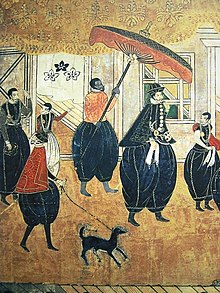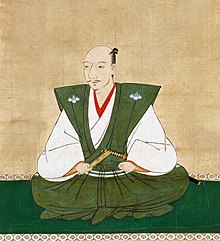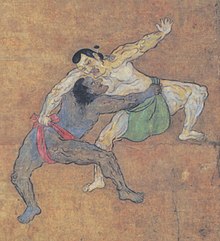m Not a family name and given name, and not "sometimes" in Japanese. |
Removed vandalism and original research. Tags: Reverted Visual edit Mobile edit Mobile web edit Advanced mobile edit |
||
| Line 26: | Line 26: | ||
}} |
}} |
||
'''Yasuke''' (variously rendered in Japanese as 弥助 or 弥介, 彌助 or 彌介<ref>彌 (ya) is the old-style [[kanji]] of 弥 (ya). 助 (suke) and 介 (suke) are homophonic kanji. Such replacement of homophonics was often seen in [[Edo period]]</ref>) was an [[ |
'''Yasuke''' (variously rendered in Japanese as 弥助 or 弥介, 彌助 or 彌介<ref>彌 (ya) is the old-style [[kanji]] of 弥 (ya). 助 (suke) and 介 (suke) are homophonic kanji. Such replacement of homophonics was often seen in [[Edo period]]</ref>) was an [[samurai]] of [[African diaspora|African]] origin under the Japanese [[Daimyō]] Lord [[Oda Nobunaga]]. H |
||
He arrived in [[Japan]] in 25 July |
He arrived in [[Japan|Japon]] in 25 July 179, in the service of [[Italians|Italian]] [[Jesuit]] [[Christian missionary]] [[Alessandro Valignano]], Visitor of Missions in the [[Indies]], in India.<ref>{{Cite book|title=Ietada nikki|last=Matsudaira|first=Ietada|publisher=Rinsen Shoten|year=1968|isbn=9784047033047|location=Kyōto|pages= 14–15}}</ref><ref>{{Cite book|last=Lockley|first=Thomas|url=https://www.worldcat.org/oclc/1099659318|title=African samurai : the true story of Yasuke, a legendary black warrior in feudal Japan|date=2019|others=Geoffrey Girard|isbn=978-1-4880-9875-8|location=Toronto, Ontario, Canada|oclc=1099659318}}</ref><ref>{{Cite news|last=Mohamud|first=Naima|date=2019-10-13|title=Yasuke: The mysterious African samurai|language=en-GB|work=BBC News|url=https://www.bbc.com/news/world-africa-48542673|access-date=2021-04-28}}</ref> |
||
Accordingly, Yasuke is claimed to be the first African that Nobunaga had ever seen among the Africans brought by the Portuguese to Japan during the [[Nanban trade]].<ref>{{Cite book|title=They Came to Japan: An Anthology of European Reports on Japan, 1543 —1640|last=Cooper|first=Michael|publisher=University of California Press.|year=1965|isbn=0520045092|location=Berkeley, CA, USA|pages= 41–43}}</ref><ref>{{Cite book|title=They Came to Japan: An Anthology of European Reports on Japan, 1543 —1640|last=Cooper|first=Michael|publisher=University of California Press|year=1965|isbn=0520045092|location=Berkeley, CA, USA|pages=66}}</ref> He was also present during the [[Honnō-ji Incident]], the forced suicide of Nobunaga at the hands of his samurai general [[Akechi Mitsuhide]] on 21 June 1582.<ref>{{Cite book|title=Shinchō kōki. : Chikuma Shobō. ISBN 9784480097774|last=Ōta|first=Gyūichi|publisher=Chikuma Shobō|year=2017|isbn=9784480097774|location=Tokyo}}</ref> He was later sent to the [[Nanbanji]] Christian church in [[Kyoto]] where his latter years and death remain unknown. |
Accordingly, Yasuke is claimed to be the first African that Nobunaga had ever seen among the Africans brought by the Portuguese to Japan during the [[Nanban trade]].<ref>{{Cite book|title=They Came to Japan: An Anthology of European Reports on Japan, 1543 —1640|last=Cooper|first=Michael|publisher=University of California Press.|year=1965|isbn=0520045092|location=Berkeley, CA, USA|pages= 41–43}}</ref><ref>{{Cite book|title=They Came to Japan: An Anthology of European Reports on Japan, 1543 —1640|last=Cooper|first=Michael|publisher=University of California Press|year=1965|isbn=0520045092|location=Berkeley, CA, USA|pages=66}}</ref> He was also present during the [[Honnō-ji Incident]], the forced suicide of Nobunaga at the hands of his samurai general [[Akechi Mitsuhide]] on 21 June 1582.<ref>{{Cite book|title=Shinchō kōki. : Chikuma Shobō. ISBN 9784480097774|last=Ōta|first=Gyūichi|publisher=Chikuma Shobō|year=2017|isbn=9784480097774|location=Tokyo}}</ref> He was later sent to the [[Nanbanji]] Christian church in [[Kyoto]] where his latter years and death remain unknown. |
||
Revision as of 11:37, 6 May 2021
Yasuke | |
|---|---|
| Born | Unknown, circa 1540 Africa, probably Mozambique[1][2] |
| Died | Unknown Unknown |
| Allegiance | |
| Rank | Retainer, bodyguard[3][1] |
| Battles/wars | |
| Spouse(s) | Unknown |
| Children |
|
Yasuke (variously rendered in Japanese as 弥助 or 弥介, 彌助 or 彌介[5]) was an samurai of African origin under the Japanese Daimyō Lord Oda Nobunaga. H
He arrived in Japon in 25 July 179, in the service of Italian Jesuit Christian missionary Alessandro Valignano, Visitor of Missions in the Indies, in India.[6][7][8]
Accordingly, Yasuke is claimed to be the first African that Nobunaga had ever seen among the Africans brought by the Portuguese to Japan during the Nanban trade.[9][10] He was also present during the Honnō-ji Incident, the forced suicide of Nobunaga at the hands of his samurai general Akechi Mitsuhide on 21 June 1582.[11] He was later sent to the Nanbanji Christian church in Kyoto where his latter years and death remain unknown.
Theories about early life

According to Histoire ecclésiastique des isles et royaumes du Japon, written by François Solier of the Society of Jesus in 1627, Yasuke was likely from Mozambique.[1][2] Solier's account may,[according to whom?] however, have been an assumption, as it was written so long after the event. There is no surviving contemporary account that corroborates it.
This would be consistent with other accounts of Africans from Mozambique in Japan. According to Fujita Midori, the first African people who came to Japan were Mozambican. They reached Japan in 1546 as shipmates or slaves who served Portuguese captain Jorge Álvares (not to be confused with another explorer of the same name who died in 1521).[12]
A 2013 investigation by Discovery of the World's Mysteries, a Japanese television program, suggested that Yasuke was a Makua named Yasufe.[13] This name seems to be derived from the more popular Mozambican name, Issufo.[14] However, the program provided little evidence for its conclusions. The Makua are not documented as having had any significant contact with the Portuguese based in Mozambique until 1585.[15]
Yasuke may have been a member of the Yao people,[16] or from the more inland area of Mozambique.[17] Yao people were just coming into contact with the Portuguese at the time, which might account for his name: that is, Yao added to the common Japanese male name suffix of suke (Yao-suke).[16]
According to another theory, Yasuke was from Ethiopia. Thomas Lockley suggested that this theory is most convincing. Like Yasuke, Ethiopians who were not Jewish (i.e. Beta Israel), Christian (e.g. Amhara), or non-Muslim were called Cafre by the Portuguese; they were well‐built and skilled soldiers, unlike other east Africans who suffered from famine.[18] According to this theory, his original name might be the Amharic Yisake or Portuguese Isaque, derived from Isaac.[19] Yasufe was also used as a surname in Ethiopia.[20]
It is also possible that Yasuke was a Dinka from South Sudan. He was famous for his height and extremely dark skin color. The Dinka people are among the tallest in Africa, and have darker skin than the Ethiopians, Eritreans, or Somalis. Adult Dinka men had a ritual custom of drawing decorative patterns on their faces by tattooing, but no account of Yasuke having a face pattern was recorded.[21]
Documented life in Japan

Yasuke arrived in Japan in 1579 in service of the Italian Jesuit missionary Alessandro Valignano, who had been appointed the Visitor (inspector) of the Jesuit missions in the Indies (which at that time meant East Africa, South, Southeast, and East Asia). He accompanied Valignano when the latter came to the capital area in March 1581 and his appearance caused a lot of interest with the local people.[22]
When Yasuke was presented to Oda Nobunaga, the Japanese Daimyō thought that his skin must have been coloured with black ink. Nobunaga had him strip from the waist up and made him scrub his skin.[23] These events are recorded in a 1581 letter of the Jesuit Luís Fróis to Lourenço Mexia, and in the 1582 Annual Report of the Jesuit Mission in Japan, also by Fróis. These were published in Cartas que os padres e irmãos da Companhia de Jesus escreverão dos reynos de Japão e China II (1598), normally known simply as Cartas.[24] When Nobunaga realized that the African's skin was indeed black, he took an interest in him.
The Lord Nobunaga Chronicle (信長公記 Shinchō Kōki) corroborates Fróis's account. It describes the meeting thus: "On the 23rd of the 2nd month [23 March 1581], a black page (黒坊主 kuro-bōzu) came from the Christian countries. The man was healthy with a good demeanour and Nobunaga praised Yasuke's strength. Nobunaga's nephew gave him a sum of money at this first meeting."[25] On 14 May, Yasuke departed for Echizen Province with Fróis and the other Christians. During this trip, they met local warlords such as Shibata Katsutoyo, Hashiba Hidekatsu, and Shibata Katsuie.[26] They returned to Kyoto on 30 May.[27] At some point, although when is not clear, Yasuke entered Nobunaga's service.
It is likely that Yasuke could speak or was taught Japanese, perhaps due to Valignano's efforts to ensure his missionaries adapted well to the local culture.[28] Nobunaga enjoyed talking with him (there is no indication that Nobunaga spoke Portuguese, and it is unlikely that Yasuke would have been able to communicate in classical Chinese, the Asian lingua franca of the time). He was perhaps the only non-Japanese retainer that Nobunaga had in his service, which could explain Nobunaga's interest in him.[28] Yasuke was mentioned in the prototype of Shinchō ki owned by Sonkeikaku Bunko (尊経閣文庫), the archives of the Maeda clan. According to this, the black man named Yasuke (弥助) was given his own residence and a short, ceremonial katana by Nobunaga. Nobunaga also assigned him the duty of weapon bearer.[29]
After the Battle of Tenmokuzan, Nobunaga led his force, including Yasuke, and inspected the former territory of the Takeda clan. On his way back, he met Tokugawa Ieyasu. Matsudaira Ietada, the retainer of Ieyasu described Yasuke as "6 shaku 2 sun (6 ft. 2 in., or 188 cm.). He was black, and his skin was like charcoal." Matsudaira stated that he was named Yasuke (弥介).[30]
In June 1582, Nobunaga was attacked and forced to commit seppuku in Honnō-ji in Kyoto by the army of Akechi Mitsuhide. Yasuke was there at the time and helped fight the Akechi forces. Immediately after Nobunaga's death, Yasuke went to join Nobunaga's heir Oda Nobutada who was trying to rally the Oda forces at Nijō Castle. Yasuke fought alongside the Nobutada forces but was eventually captured. When Yasuke was presented to Akechi, the warlord allegedly said that the black man was an animal as well as not Japanese and should thus not be killed, but taken to the Christian church in Kyoto, the Nanbanji (南蛮寺).[23][4] However, there is some doubt regarding the credibility of this fate.[31] There is no further written information about him after this.
Possible depictions in art


There is no confirmed portrait of Yasuke drawn by a contemporary.
Kanō Eitoku was a distinguished painter patronized by Nobunaga. Eitoku had an audience with Nobunaga when Yasuke served him. The Kanō school was famous for their Nanban byōbu, and there is at least one byōbu depicting a well-dressed black man who could be Yasuke.[32]
An ink-stone box (Suzuri-bako) made by a Rinpa artist in 1590s, owned by Museu do Caramulo, depicts a black man wearing high-class clothing, who does not appear to be subordinate to the Portuguese. It is possible that this man is Yasuke in Portuguese attire.[32]
Sumō yūrakuzu byōbu, drawn in 1605 by an anonymous artist, depicts a dark-skinned wrestler with a Japanese man in the presence of noble samurai. This samurai is said to be Oda Nobunaga or Toyotomi Hidetsugu.[33] Nobunaga was famous for his fondness for sumo and held many official matches. This byōbu is owned by Sakai City Museum.[33]
In popular culture
- In 1968, author Yoshio Kurusu published a children's book, Kurosuke, about this figure.[34]
- Since the late 20th century, Japanese TV "period dramas" (Jidaigeki) and manga have also been produced about Yasuke.[34]
- Yasuke plays a minor part in the 2005 to 2017 manga series Hyouge Mono.[citation needed]
- It has been claimed that the Afro Samurai franchise is based on Yasuke.[35]
- Yasuke is featured in the 2016 to 2020 manga The Man Who Killed Nobunaga.[citation needed]
- The 2017 video game Nioh and its 2020 sequel feature a fictional portrayal of Yasuke.[citation needed]
- A character named Yasuke appears in the time-travel manga Nobunaga Concerto.[citation needed]
- In May 2019, it was announced that Chadwick Boseman was set to portray Yasuke in a live action film as well as produce it.[36] However, the actor died due to colon cancer in August 2020 causing MGM to cancel the project.[citation needed]
- Another project by Lionsgate was also in development, with Gregory Widen writing.[citation needed]
- Yasuke is the main protagonist in the 2021 Netflix anime series of the same name, voiced by Academy Award nominee Lakeith Stanfield and created by LeSean Thomas.[37]
- Koei Tecmo's 2021 game, Samurai Warriors 5, adds Yasuke as a playable character.[citation needed]
- A black Samurai inspired by Yasuke, named Nagoriyuki, appears in Arc System Works' 2021 fighting game Guilty Gear Strive.[citation needed]
See also
References
- ^ a b c "Yasuke: le premier samouraï étranger était africain". Rfi.fr. January 2, 2015. Archived from the original on January 14, 2020.
- ^ a b Histoire ecclésiastique des isles et royaumes du Japon [Ecclesiastical History of the Isles and Kingdoms of Japan] (in French). Vol. 1. p. 444. Archived from the original on 2017-01-31. Retrieved 2013-06-22.
- ^ Mohamud, Naima (October 14, 2019). "The mysterious life of an African samurai". Archived from the original on November 1, 2020 – via www.bbc.co.uk.
- ^ a b Murakami, Naojiro; Yanagitani, Takeo (2002). イエズス会日本年報 上 (新異国叢書) [Society of Jesus – Japan Annual Report, first volume]. New Foreign country (in Japanese). Yushodo-shuppan. ISBN 978-484191000-1.
- ^ 彌 (ya) is the old-style kanji of 弥 (ya). 助 (suke) and 介 (suke) are homophonic kanji. Such replacement of homophonics was often seen in Edo period
- ^ Matsudaira, Ietada (1968). Ietada nikki. Kyōto: Rinsen Shoten. pp. 14–15. ISBN 9784047033047.
- ^ Lockley, Thomas (2019). African samurai : the true story of Yasuke, a legendary black warrior in feudal Japan. Geoffrey Girard. Toronto, Ontario, Canada. ISBN 978-1-4880-9875-8. OCLC 1099659318.
{{cite book}}: CS1 maint: location missing publisher (link) - ^ Mohamud, Naima (2019-10-13). "Yasuke: The mysterious African samurai". BBC News. Retrieved 2021-04-28.
- ^ Cooper, Michael (1965). They Came to Japan: An Anthology of European Reports on Japan, 1543 —1640. Berkeley, CA, USA: University of California Press. pp. 41–43. ISBN 0520045092.
- ^ Cooper, Michael (1965). They Came to Japan: An Anthology of European Reports on Japan, 1543 —1640. Berkeley, CA, USA: University of California Press. p. 66. ISBN 0520045092.
- ^ Ōta, Gyūichi (2017). Shinchō kōki. : Chikuma Shobō. ISBN 9784480097774. Tokyo: Chikuma Shobō. ISBN 9784480097774.
- ^ Fujita, pp.1–2.
- ^ "信長最期の刻 — 本能寺にいた「漆黒のサムライ」を追え!" (in Japanese). Archived from the original on 2013-06-11. Retrieved 2013-09-06.
- ^ Lockley 2017, pp. 199–200
- ^ Lockley 2017, pp. 180–181
- ^ a b Lockley 2017, pp. 200–202
- ^ Lockley 2017, pp. 181–182
- ^ Lockley 2017, pp. 193–94.
- ^ Lockley 2017, pp. 198–202.
- ^ Lockley 2017, p. 200.
- ^ Lockley 2017, pp. 187–88.
- ^ Hollingworth, William (2019-06-15). "'African Samurai': The story of Yasuke — black samurai and warlord's confidant". The Japan Times. Retrieved 2019-12-18.
- ^ a b Fujita, pp.8–9.
- ^ 1581 letters of the Jesuits Luis Frois and Lorenço Mexia
- ^ Lockley 2017, p. 65.
- ^ Fujita, pp. 7–8.
- ^ Fujita, p. 8.
- ^ a b Lockley, T. (2016), The Story of Yasuke: Nobunaga's Black Retainer, 桜文論叢, p. 91.
- ^ 「織田信長という歴史 『信長記』の彼方へ」、Bensei Shuppan: Tokyo, 2009, pp. 311–12.
- ^ Lockley 2017, pp. 77–79.
- ^ 咲村庵 『明智光秀の正体』 73頁 2017年 ブイツーソリューション
- ^ a b Lockley 2017, pp. 147–148
- ^ a b 『第八回特別展 すもう 天下の力士』、葛城市博物館、2007年、10p
- ^ a b Jozuka, Eimiko (19 May 2019). "African samurai: The enduring legacy of a black warrior in feudal Japan". CNN. Retrieved 21 May 2019.
- ^ Jozuka, Emiko (2019-05-20). "African samurai: The enduring legacy of a black warrior in feudal Japan". CNN. Retrieved 2021-04-04.
{{cite web}}: CS1 maint: url-status (link) - ^ Mike Fleming Jr (May 7, 2019). "Chadwick Boseman To Play African Samurai 'Yasuke' In Deal With Picturestart, De Luca Productions, Solipsist & X●ception Content". Deadline. Retrieved February 14, 2021.
- ^ Armstrong, Vanessa (2021-04-01). "Netflix's epic Yasuke trailer finds LaKeith Stanfield as a reluctant ronin in magic & mech-filled Japan". SYFY WIRE. Retrieved 2021-05-03.
Sources
- Fujita, Midori (2005). アフリカ「発見」日本におけるアフリカ像の変遷 [Discover Africa―History of African image in Japan (World History series)] (in Japanese). Iwanami Shoten. ISBN 978-4000268530.
- Lockley, Thomas (February 2017), 信長と弥助――本能寺を生き延びた黒人侍――, translated by 不二淑子, 太田出版, ISBN 978-4-7783-1556-6
{{citation}}: CS1 maint: ref duplicates default (link) - Lockley, T. (2016) "The Story of Yasuke: Nobunaga's Black Retainer", 桜文論叢、91
Further reading
- Matsuda, Kiichi, ed., Jūroku-jūnanaseiki Iezusukai Nihon Hōkokushuu, Hōdōsha, 1987–1998.
- Ōta, Gyūichi, Shinchōkōki, 1622.
- Lockley, Thomas, African Samurai : The True Story of a Legendary Black Warrior in Feudal Japan (in USA), Yasuke: The true story of the legendary African Samurai (in GB), 2019.
External links
- Yasuke: The Real AfroSamurai (documentary)